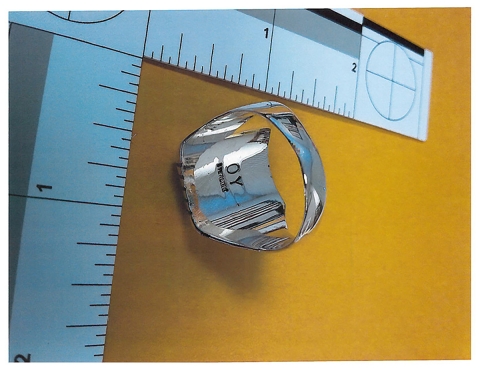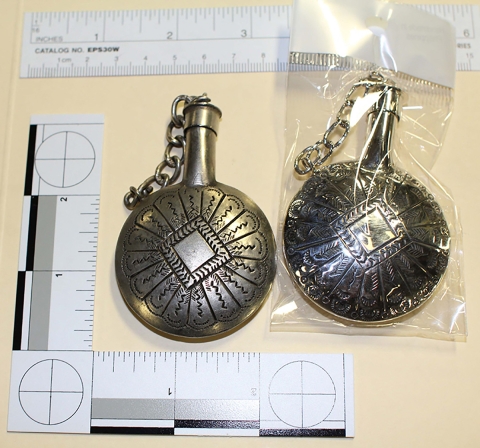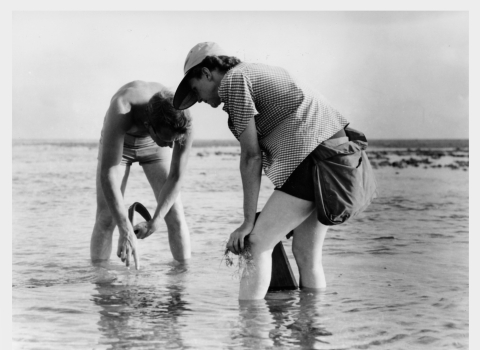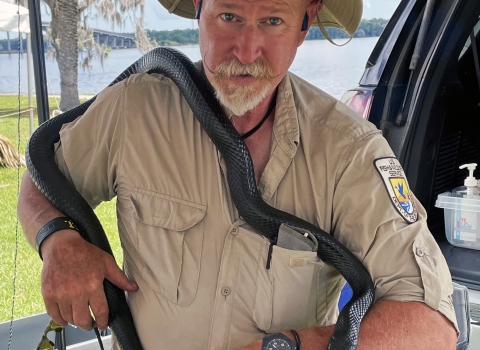Every November, our country celebrates Native American Heritage Month providing an opportunity to learn about the vast history of Native Americans and vital contributions they have made to our country. The U.S. Fish and Wildlife Service has a mandated obligation to ensure that the federal Indian trust responsibility is fulfilled, and every program of the Service has a role. (At left: Liz Wallace, a jeweler and an enrolled member of the Navajo Nation, cuts silver wire in the process of making a piece of jewelry. Photo courtesy of Liz Wallace)
The Service’s Office of Law Enforcement (OLE) supports Native Americans and Alaska Natives in numerous ways such as training tribal conservation law enforcement officers, assisting with criminal investigations, providing eagle feathers and parts for use in religious ceremonies, supporting subsistence hunting, and enforcing federal laws that protect Native American culture such as the Marine Mammal+ Protection Act, Archeological Resources Protection Act, and the Indian Arts and Crafts Act (IACA).
The IACA is a truth-in-advertising law that prohibits misrepresentation in marketing of American Indian or Alaska Native art and craft products within the United States. To enforce the IACA, the OLE works closely with Department of the Interior’s Indian Arts and Crafts Board (IACB), led by Director Meridith Stanton, an enrolled member of the Delaware Nation and a Choctaw Nation descendant.
In the initial period following the enactment of the IACA, the board worked with multiple law enforcement agencies on stopping the sale of counterfeit Native American art and craftwork, with mixed results,” Stanton says. So in in 2012, the Service and the IACB signed a Memorandum of Agreement to conduct IACA criminal investigations.
Since then, the OLE has assigned special agents to disrupt and dismantle this criminal activity and the OLE’s successes are significant. Stanton says she wanted the OLE “because not only are their investigative abilities exceptional, they have jurisdiction throughout all of the U.S. states and territories and has an international reach.” Numerous defendants have been investigated, indicted and sentenced for their crimes, and their actions were documented in states such as Alabama, Alaska, Arizona, California, New Jersey, New Mexico and Texas; and in countries such as China, Indonesia, Mexico, Pakistan, the Philippines and Thailand.
| If you believe you have knowledge about a wildlife crime, you may report it via the Service’s tip line by either calling 1- 844-FWS-TIPS (397-8477) or email fws_tips@fws.gov. |
Most of these defendants ran similar multinational criminal schemes in the Southwest United States that involved fake Native American art mass produced in the Philippines. These fakes were then smuggled into the United States and sold as authentic Indian jewelry to unaware consumers at numerous retailers throughout the United States.
These crimes were not simple to investigate because they were multifaceted and involved other serious crimes such as identity theft, mail fraud, wire fraud, smuggling, conspiracy and money laundering. Throughout these investigations, OLE agents discovered that counterfeit Indian art criminal networks operated a complex web of middlemen, across the nation, to distribute and market fraudulent Indian artwork. In addition, these defendants used their illegal sales to undercut reputable competitors often taking over their businesses. The millions of dollars generated by these counterfeit Indian art networks supported organized crime in the United States and were also funneled to overseas criminal operations.
The marketing of fraudulent Indian arts and crafts adversely affects Indian artists, businesses, tribes and economies. Many Native Americans and Alaska Natives depend on their artwork as their source of income. Without the oversight of the IACB and the OLE’s investigative efforts, the marketplace would be flooded with cheap counterfeit items and there would be little or no market for Indians to sell their authentic hand-made products. Ultimately, this would contribute to a decline of Indian tradition, culture and authentic art.
| Rewards The U.S. Fish and Wildlife Service is authorized to pay rewards for information or assistance that leads to an arrest, a criminal conviction, civil penalty assessment, or forfeiture of seized property. Payment of rewards is the discretion of the Service and is linked to specific federal wildlife laws. The amount of any reward we may pay is commensurate with the information or assistance received. |
Liz Wallace is a Santa Fe, New Mexico, based jeweler and an enrolled member of the Navajo Nation. Her jewelry styles are classic Navajo and Art Nouveau. While the Navajo jewelry style is rooted in millennia-old Athabascan traditions, the silver and turquoise associated with it today involves metallurgy techniques learned from Hispanic blacksmiths in the villages of northwestern New Mexico in the mid-19th century.
“Starting in the 1800s, jewelry making became important economically for Navajo men. Navajo weavings made by our women were also coveted items early on in American history,” Wallace says. “Our jewelers created this heavy silver jewelry style that makes the Navajo tradition unique. It was very different from the delicate Victorian jewelry that was mainstream during that time period.” She continues, “Years ago I had been seeing stores full of cheap knockoffs, and I saw the IACA as ineffective, and symbolic at best. But I’ve since changed my tune, especially after learning how hard Service investigators work and how dedicated they are. We hope that these convictions and prison sentences will make a big difference.”
Phil Land, the Service’s Special Agent in Charge stationed in Albuquerque, New Mexico, and the agent responsible for OLE’s investigative work throughout most the Southwest United States, knows the importance of authentic work spreads beyond the tribes. “New Mexico’s economy relies heavily on Native American art and culture,” he says, “The OLE is committed to investigating violations of the IACA to protect the Native American cultural heritage. If a person visiting New Mexico goes into a store to buy Native American made jewelry, they should have the confidence that they are getting authentic work and vendors who misrepresent Native American made jewelry will be held accountable.”
While investigating counterfeiters is an effective deterrent, the consumer should also take steps to ensure their purchase is legitimate by asking about the history and authenticity of the piece.
“The best thing for people to do is their homework and to think of that authentic Native American artwork as an investment,” Wallace says. “Buy from a reputable vendor or, even better, directly from the artists. Each piece has a history, it has traditions and heritage that go with it, and when you buy an authentic piece, you’re honoring that culture and heritage.”
To assist the consumer, the IACB’s website posts a Source Directory of federally recognized Indian artists and arts businesses, and you can also report a suspected IACA crime here.
This story is part of our Open Spaces blog.








